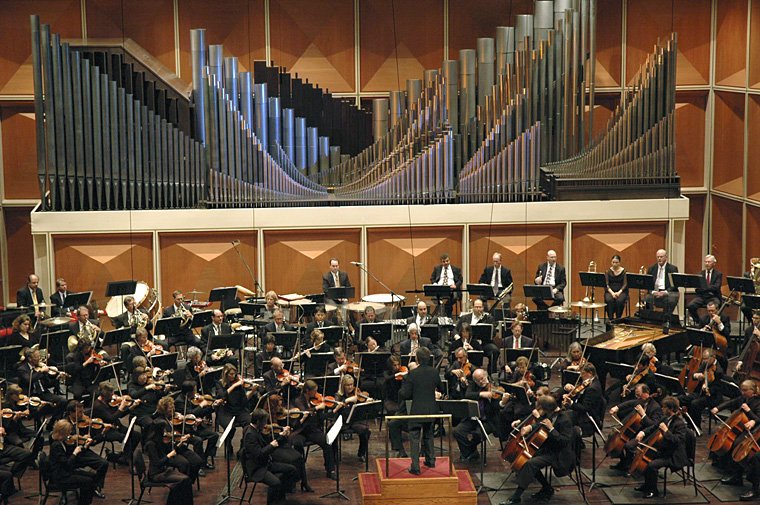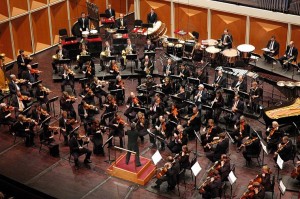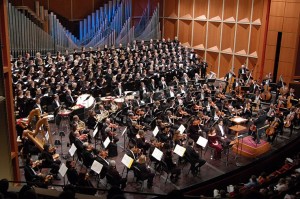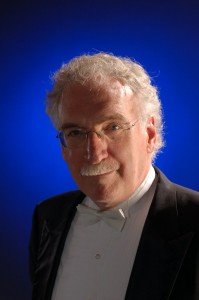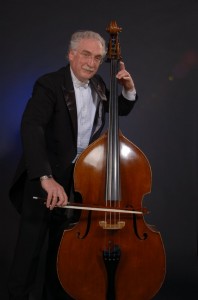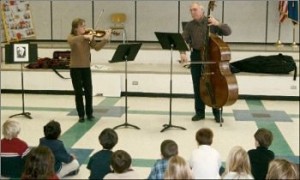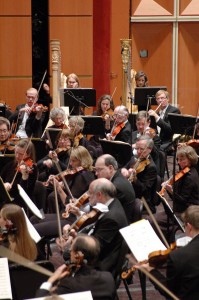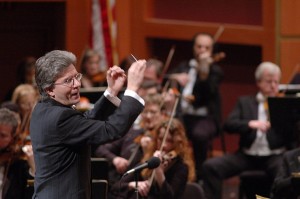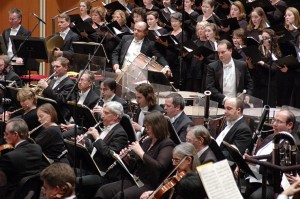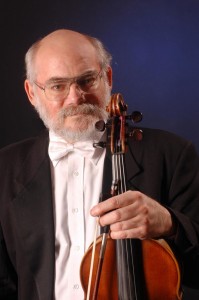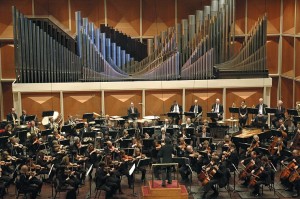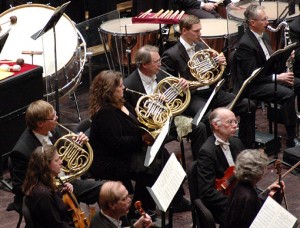Milwaukee Symphony Orchestra
About the Ensemble
The Milwaukee Symphony Orchestra, now in its 47th season, is one of the youngest of the top 20 American symphonies. Musicians and staff alike attribute its relative youth to the proximity of the Chicago Symphony, which frequently performed in Milwaukee in the early part of the century, and continued to give up to 10 subscription concerts in Milwaukee until the mid-1980s.
For all its youth, the MSO has had an illustrious career, touring nationally and internationally, performing often at Carnegie Hall, and even touring Cuba in 1999, the first American orchestra to do so since the late 1950s.
Founded in 1959 with Harry John Brown as its first music director, the MSO gained national prominence during the Kenneth Schermerhorn years (1968 to 1980). Schermerhorn initiated the MSO’s state touring program and worked with the legendary Margaret Hawkins to form the Milwaukee Symphony Chorus. The Milwaukee Symphony Chorus is a true gem – one of the best symphony choruses in the country. After Ms. Hawkins untimely passing in 1993, the role of director passed to her protégé, Lee Erickson, who has continued the tradition of choral excellence.
Lukas Foss took over the podium in 1981 and instituted a increased focus on contemporary and American music. In 1986 he led the MSO on its first European tour. The podium passed to Zdenek Macal in 1986; he led the MSO on a tour of Japan in 1992, among other noted achievements.
Andreas Delfs became music director in 1997 and, over the course of his ten years with the symphony, has brought the orchestra much acclaim for its artistic brilliance and his innovative programming. Indeed, the Milwaukee Symphony consistently performs at a level far above what might be expected for a city the size of Milwaukee. Maestro Delfs has announced that he will step down from the music director position at the end of the 2008-09 season, the orchestra’s 50th anniversary season.
=> View an excerpt from a video interview with Maestro Delfs.
In the 1990s, the Milwaukee Symphony began to seriously grow its education and outreach programs. The MSO’s ACE (Arts in Community Education) program integrates music and arts into the classroom in schools throughout greater Milwaukee. 35 ensembles, comprised of over 100 MSO musicians and local cultural partners, visit the schools throughout the year, providing arts experiences while supporting the ACE and core curriculum. Currently three ACE ensembles visit each classroom annually, totaling more than 420 in-school visits and reaching more than 40,000 students annually. In addition, each school holds a Family Night concert and the ACE program presents grade-specific concerts at Uihlein Hall. The ACE program has been a model for many other orchestras formulating their own education/outreach programs.
The Milwaukee Symphony performs regularly at Uihlein Hall at the Marcus Center for the Performing Arts. They will play 95 concerts in the 2305-seat hall this season, but will also give 45 performances in other venues. Built in the mid-1960s, Uilhein Hall features a 30,000-lb. pipe organ, built by the Aeolian Skinner Company, which is stored 30 feet under the stage, and is be raised to stage level by its own elevator.
The orchestra has experienced financial troubles in recent years – a situation oh too common with many American orchestras. However, the board and musicians put together a 3-year plan to reduce expenses and raise $15 million to retire their accumulated deficit and put them on firm financial ground for the future. Since then, they’ve been working with former San Francisco President Peter Pastreich on refining that plan. MSO President and Executive Director, Mark Hanson, explains how the plan came about and asserts that they remain on target for this season. (See page 3 of this spotlight for an interview with Mark.)
In light of these financial difficulties, the 88 contracted musicians agreed to a concessionary 3-year contract in 2005, cutting their season by 4 weeks – from 43 weeks to 39 weeks, which reduced a section player’s yearly salary from $59,125 to $53,625. Roger Ruggeri, bassist and chair of the Players’ Council, said that the musicians were disappointed, but hopeful that the contract would strengthen the orchestra in the long term. (For more insights from Roger, see page 2 of this spotlight.)
But perhaps the MSO’s most noted initiative is its ventures into new technologies. The orchestra has been doing national radio broadcasts continuously since 1976; these performances have aired in hundreds of cities nation-wide. Few other orchestras can claim such a catalogue of roughly 400 performances on tape. In the fall of 2005, the MSO decided to offer these broadcasts, under the “MSO Classics” label, for purchase as downloads on Apple’s iTunes website. No other orchestra had ever done such a thing before, though several, including Los Angeles, Minnesota, New York, and St. Paul, have followed suit.
Making use of the AFM’s Internet media agreement, ratified in 2000, which allows for local determination of the specifics of an Internet download or streaming agreement, the MSO has decided that 40% of the revenue from all Internet sales (including the MSO Online Store) will go to the musicians, with adjustments to recompense guest artists. At this point, no one is getting rich from this agreement, but the Milwaukee Symphony has received international attention for its pioneering strides into the world of symphonic Internet downloads. Robert Levine, Principal Violist and one of the chief negotiators of the 2000 AFM Internet agreement, has written a detailed explanation of how the MSO’s iTunes initiative came about – see page 4 of this spotlight.
In addition to selling “product” on iTunes, the MSO has also embarked on a revolutionary recording project using 19th century technology – binaural recordings. Using a dummy of a human head with microphones in both ears, these recordings present the sound of a concert as if one were hovering 10 feet above and behind the conductor. Binaural microphones were first used in the late 19th century, but have come back into fashion because of the prevalence of the use of earphones, particularly with owners of iPods and MP3 players. The quality of the recordings cannot really be appreciated over traditional speakers; headphones are a must. Page 5 of this spotlight presents a description of the binaural recording project, written jointly by Robert Levine and Tracy Johnson, former PR Director of the MSO, as well as a photograph of the recording device itself.
Polyphonic.org salutes the Milwaukee Symphony for its continued successes and innovations!
Ann Drinan, Polyphonic Senior Editor, February 2007
Interview with Roger Ruggeri, Bassist and Chair of the MSO Players’ Council
Roger Ruggeri has been with the Milwaukee Symphony since 1963 and served as its Principal Bassist until stepping down in 2005. In addition to playing bass, Roger Ruggeri is active as a composer, program annotator and lecturer, and has taught at UW Madison and UW Milwaukee. He’s a member of the Executive Board of Local 8 of the AFM, a musician representative to the MSO board, and is currently chair of the Players’ Council. Ann Drinan, Polyphonic Senior Editor, spoke with Roger over the phone about the musicians’ perspectives on the MSO financial problems and its recent technology initiatives.
Ann Drinan: How would you describe the health of the MSO?
Roger Ruggeri: The orchestra is in a state of quiet crisis. Its financials are quite challenging, but the board is getting better, and more people are involved who not only love music but also have some financial means. That is better. But we’re in year 3 of a 3-year plan to raise $15 million to retire a $10 million deficit. The only thing we’ve gotten out of it so far is the musicians’ cooperation in terms of cutting back the season.
The idea was that the organization would find itself recapitalized, and what happened was that there was a donor who provided the orchestra with a million dollars a year, who died 6 or 7 years ago. The will had a gift of $10 million, unspecified as to use. The people in charge of things (perhaps former board members on the endowment committee) determined that the money would be assigned to the endowment. And money was borrowed from a bank against this gift. However, the bequest didn’t start earning returns because it was tied up in probate for quite a while.
The orchestra didn’t want to call it bridge funding but rather used it as collateral on a loan. The organization had been on this road for a while.
It’s important for a musician to learn to see things from the board member’s vantage point, because it increases the chance that musicians’ viewpoints will become part of the decision-making process; something that will ultimately be better for the organization.
AD: What are the current budget issues? You still need $8.7 million in special funding?
RR: We have raised around $6.8 million of the $15 million target – they allege that they have pledges for the remainder. Management will find good ways to say things, to put a positive spin on what’s happening – we must examine these statements closely.
For example, the increase in Classical Connections ticket sales is very good, but we started with 400 people in a 2200-seat hall. The percentage increase is impressive vs. how many people are actually there.
AD: The savings have come from a new labor contract that reduced musicians’ employment from 43 weeks per year to 39, reductions in the office staff, and from a slightly reduced season at Marcus Center’s Uihlein Hall. How do the musicians feel about this?
RR: The musicians have been trying to be intelligent and understanding, etc., etc., about all this, and what has happened is that we’re being treated increasingly like amateurs, in the sense that the “powers that be” seem to be assured that we’ll do what we do now for a lot less than we did before. We are a large part of why this orchestra exists – why it plays at the level it does, yet why are our salaries not higher than they are? We used to be on a par salary-wise with Baltimore, both weekly and annually. It’s just not true that Milwaukee is a cheaper place to live. Indianapolis is reasonably secure.
Management would have been happy with the same length season for $10K less, but we didn’t want to go there. The problem with the leadership of our orchestra is that they are primarily concerned with fiduciary responsibility vs. having actual artistic objectives or figuring out ways to get there. Without vision, your response to difficulties is to constantly shrink.
I recommend the book Governance is Leadership by Chait, Ryan, and Taylor. These authors address issues that are happening here in Milwaukee – the board members are stuck on the first of the three parts of board responsibility (fiduciary), and are ignoring objectives and strategy. We’re looking for a new music director – we will be challenged to get the person we want if the organization has no objectives. If a music director wants to do something innovative and is only told no, s/he won’t stick around. It’s a formula for mediocrity.
AD: How do the MSO musicians feel about the iTunes project?
RR: It was driven by the musicians’ leadership and was not particularly driven by staff. It’s kind of remarkable. But it’s one of the only things we could do – we don’t tour or record, although we do radio broadcasts. We’re leading the way in the technological area – it seemed a good place for us to address our energies. Robert Levine, Samantha George, and I were involved at the outset; later Andrea Leung joined the LIOC (Local Internet Oversight Committee).
It was not too difficult to get musician approval – it might have been if it was a management objective, but the musicians went along with it because musicians were promoting it. It’s not a big money-maker but it brings notoriety and hopefully will lead to other things. It’s not a miracle cure but it continues to be positive.
AD: The MSO has an interesting outreach program, the ACE program. Is it working well? Should it be considered a model for the rest of the country?
RR: There’s a great deal to be said for it; it’s a good program. I’ve been involved since the beginning – I do a kindergarten program, and my wife, Andrea Wagoner (an MSO violinist), and I do a presentation about composing. We present an ACE family, with four groups in the family: performers, conductor, composer, and audience. We have kids identify themselves as audience, and then go from there. Each grade level has a different item to investigate – later, for example, becoming “ACE detectives.”
Interview with Mark C. Hanson, President and Executive Director
Mark Hanson became President and Executive Director of the Milwaukee Symphony in January, 2004. He came to Milwaukee from the Knoxville Symphony. Ann Drinan, Polyphonic Senior Editor, interviewed Mark by telephone about the orchestra’s financial situation and their 3-year plan to return the institution to financial stability.
Ann Drinan: You’re currently in the 2nd year of your 3-year $15 million initiative. You’ve raised $6.3 million as of last June. How do you think the remainder of the initiative will do? Will you meet your goal?
Mark Hanson: We are making progress but have not yet completed the plan. When we created the plan in early 2004, the MSO was facing a $3.5 million forecasted deficit for the year (we ended with a $2.9 million deficit in 2003-2004). The $15 million plan is a roadmap for getting us from that deficit to a balanced budget by the end of the 2006-07 season. The plan required several elements – a turn-around in ticket sales, a significant increase in contributed income, and $1 million reductions in both the artistic and administrative budgets.
Another component of the plan was raising $15 million in recapitalization funding. This funding will enable us to pay off about 20 years of accumulated debt that was $11 million at its peak: $6 million in a loan from a bank, and $5 million in a loan from our own endowment. Once we raise the $15 million, we’ll have paid off both these loans and will have used the remaining amount to fund the financial plan – to cover the budgeted deficits that were called for in years 1 & 2 of the plan. The $6.3 million we’ve raised so far has allowed us to cover those budgeted deficits and to repay $2 million of the $5 million we owe to the endowment. The remaining dollars to be raised will pay off the rest.
It has taken us longer to raise the sum than we’d anticipated, in large part because there’s no more difficult fund-raising campaign than paying off accumulated debt – we’re asking our core supporters to donate million-dollar gifts to pay off past mistakes, not to support a new building, new orchestra positions, or an expansion of our programming. It’s been tough. But we have some hot prospects waiting in the wings who are becoming more comfortable with investing in the recapitalization campaign because we’re within spitting distance of successfully completing this financial plan – they’re realizing that it’s possible to shore up the MSO’s financial position without compromising artistic quality, programmatic depth, or the commitment to the community.
Our goal has been to stabilize the institution’s finances while looking for ways to grow the institution, both programmatically and artistically. We have implemented the Tessitura database system developed by the Metropolitan Opera, which is vastly superior to our previous marketing and development database software. We’ve nearly doubled the number of performances outside the Marcus Center for the Performing Arts (our main performance space, Uilein Hall, is inside the Marcus Center). And we’re making ourselves more visible throughout the community. We’ve introduced the new 6-concert Thursday evening Classical Connections series that represents growth. And we are all focused on reaching new audiences through innovative recording projects, such as the creation of our own e-label, our groundbreaking relationship with iTunes, and the development of our very own music store on the MSO website. All of these new initiatives have been launched within the framework of the financial plan.
Our presence on iTunes has also brought us a huge amount of local, national, and international press and attention – it’s won us a lot of fans. This is a great example of a growth initiative that’s been possible even though we’ve been making tough decisions in an effort to stabilize our finances.
AD: What is the current financial condition of the Milwaukee Symphony? Last season you had a deficit of about $671,000 and you budgeted a surplus of $11,000 for this season. Are you still on target?
MH: We’ve been operating since the spring of 2004 under the 3-year financial plan. We’re on track to successfully turn in a balanced operating performance for year 3. It has required a lot of cooperation from the members of the orchestra, who agreed to a concessionary contract at the beginning of year 2; from the current administrative staff, which is 30% smaller than the previous staff team; and it’s required the involvement and support of thousands of donors who have helped us to significantly increase the amount of annual support provided to the MSO from individuals, corporations, and foundations.
AD: How do you account for the increase in ticket sales? You had a 9% increase in subscribers this year.
MH: There was a huge increase in single ticket sales in the past two seasons, as well as subscriptions in the current season – in part because of our expanded community profile. But this certainly doesn’t take away from the other reasons: top-notch performances by our musicians and guest artists, more effective, creative and targeted marketing of concerts, exciting programming, and increased community buzz in general. Folks are hearing about more and more sell-outs, are hearing about our renewed financial vigor, and are responding to that positive press – to that excitement – by purchasing tickets.
AD: Artistically speaking, where is the MSO now and where do you think it is going?
MH: Even though we’re the youngest top 20 orchestra in the country, we’ve had a storied history. We’ve performed at Carnegie Hall 11 times, we’ve toured nationally and internationally, and we have a rich recording history. This is all somewhat surprising, given our age – we’ve existed under the shadow of the Chicago Symphony all of our 48 years. We have an opportunity, once our financial picture is healthier, to re-establish a national and international presence that, over the past few years, has been impacted by our financial situation. In the midst of our growing annual deficit, in the midst of an almost overwhelming debt load, this institution had to make some decisions that diminished our profile and national/international reputation. However, with our e-label, our new concert series, the continuing national radio broadcast series, expanded regional and national touring, and exciting concerts and commissions, we can re-establish a higher profile.
That’s not enough for us, however. As an institution we believe it’s more important to grow local support and local attendance. That needs to be our first priority, and only when we have regrown our audience base and developed a larger, healthier support base, can we dream of again making a national and international presence. We will build on our programs, projects, and initiatives to grow our national and international platform.
AD: How will the departure of Andreas Delfs impact the organization?
MH: It must be noted that Andreas has done a huge favor to the MSO by giving us over two years notice of his departure. This type of notice provides us the opportunity to celebrate his contribution to the MSO as music director, and gives us at least two full seasons to conduct an international search for his successor. From a lot of angles, the next two years are a great opportunity for the MSO to attract larger audiences, and to generate more local support as well as more national and international attention. Over these two seasons, we will feature Andreas’ last concerts as music director and concerts conducted by potential successors. It’s an exciting combination of events that will make the MSO’s 50th anniversary season in 08-09 one of the most exciting yet. We will celebrate his accomplishments and legacy, celebrate our rich history over the past 50 years, and announce a new music director all within two seasons.
The search committee includes five elected musicians and five members of the board chosen by the board chair, plus the concertmaster and board chair who both serve as non-voting ex-officio members. The committee is already up and running, reviewing potential candidates, and helping us make guest conductor decisions.
AD: How would you describe your musician/board/staff relations?
MH: A good relationship is critical for the success of this institution going forward. Milwaukee was one of the first orchestras in the country to jump on that wagon. At the present time, two musicians serve on the board and many other musicians serve on board committees. Beyond that, we’ve had an implementation committee that, over the past year and a half, has been working with Peter Pastreich to literally implement the recommendations that were included in an 18-page report that Peter wrote in the summer of 2005. That committee of board members and musicians (3 elected musicians, 3 board members, the board chair and myself) has been working with Peter and has focused on the areas of board strength, artistic planning, financial planning, recapitalization funding, and the other items that Peter had identified as needing the attention of this joint task force.
It’s a wonderful example of a group of musicians and board members working with the board chair and executive director on strengthening the institution while tackling some meaty and sometimes difficult issues in a collaborative fashion. So far the results have, for the most part, been very positive.
Beyond the official agenda items, it’s given us an arena in which to talk about issues that naturally come up from time to time. If you don’t have a functioning committee like this one, there isn’t necessarily a place for important discussions to resolve conflicts and issues that show their ugly head from time to time.
AD: What has been the success of the iTunes project? Is the MSO still making radio broadcasts?
MH: Yes, we’re still doing the weekly radio broadcasts to 240 cities. The iTunes project has been hugely successful in that it has given the MSO a new international platform through which to make new friends and to expand on the rich, rich history of the MSO. It’s not only a way for us to build our local reputation as a forward-thinking innovative organization, but has also given us an international presence at relatively little cost. It’s an international platform over which we have much control.
We as an institution, through our LIOC (Local Internet Oversight Committee), make decisions that determine the future presence that we have, both on iTunes (the highest profile and most widely-used online music store) but also on www.mso.org where we now have our catalogue available. We’ve created our own version of iTunes that’s a good complement to our presence on iTunes, both for local audiences and for those who know they want an MSO recording. It’s easier because our catalogue is the only one represented on our website.
During the first 12 months, we had over 5,000 downloads through iTunes. It’s too early to know how we’re doing through www.mso.org.
AD: You’ve started playing outside Uilein Hall – in parks, universities, hospitals, etc. How are these outreach concerts being received? Any new initiatives planned?
MH: The MSO has a long history of community programs and touring within Wisconsin. We’re expanding that program and, through these performances, we can build audiences and support for our core downtown concerts. Our subscription base for our classical and pops concerts in Uilein Hall will grow over time, in part because of that expanded presence throughout the region and state. We can’t expect to market our Uilein Hall concerts through traditional media and automatically have sold-out crowds. We need to do more than just market the orchestra in those traditional, though very important, ways. One way that is effective is to perform in new venues and new communities. There is no better way to market our subscription concerts than by performing in people’s backyards.
AD: Anything else to add?
MH: Thank you for the opportunity to share our experiences through this exciting forum.
The Little Orchestra That Did:
How the Milwaukee Symphony Became the First American Orchestra to Put its Performances on iTunes
Robert Levine, Principal Violist with the MSO and resident technology guru, describes— in his own inimitable style— how the MSO came to the decision to sell their broadcast performances on iTunes.
On October 4, 2005, the Milwaukee Symphony became the first American orchestra to make previously unreleased archival recordings available for sale on iTunes and other online music stores. The story of how a young and financially struggling orchestra beat its older and richer brethren to the Internet appears at first glance to be simply a story about serendipity, but on closer examination contains both lessons and cautions for other institutions wanting to experiment with online distribution of artistic content.
The Milwaukee Symphony, formally organized in 1962, is the youngest of the 20 largest American orchestras. Milwaukee was known as a center of German culture from the mid-19th century (the so-called “German Athens”), and is the home of the only musicians’ union founded by a member of the Bach family. But the proximity and frequent presence in Milwaukee of the Chicago Symphony put a damper on the community’s desire for its own orchestra until the Golden Age of American orchestra expansion, the 1960s.
The MSO quickly developed a national reputation for artistic quality under the leadership of Music Director Kenneth Schermerhorn (1968-1980). The orchestra developed a reputation for programming innovation during the music directorship of German-born composer (and protégé of Bernstein and Copland) Lukas Foss, while its reputation as being an orchestra that “punches over its weight” artistically continued to grow during the tenures of music directors Zdenek Macal (1987-1995) and Andreas Delfs (1997-present).
While the MSO’s artistic growth has been uninterrupted since its inception, problems with finances, governance, and venues have caused the economic history of the orchestra to resemble the experience of Sisyphus with boulders. Being a young institution in a very conservative community, the MSO board has yet to become the premiere board of directors in town, which is extremely unusual for a major orchestra. Another oddity is the dependence of the MSO on a community arts fund, which, although it gives over $2 million annually to the orchestra, places severe limits on the orchestra’s ability to raise money outside of the fund’s annual campaign. Milwaukee’s comparative lack of recent experience with large non-profit institutions has made raising endowment funds even more challenging than it is for most orchestras, as has the MSO’s propensity to dip into its endowment in times of financial stress. And the absence of a venue dedicated to orchestral performances and controlled by the MSO has not only made it nearly impossible to design season schedules that make sense from a marketing standpoint, but have put much of the audience experience and (until only a few months ago) single ticket sales largely outside the MSO’s control.
Notwithstanding these very serious impediments, the MSO has maintained a continuous presence in electronic media virtually unique for an orchestra its size. The orchestra made numerous commercial recordings with Schermerhorn, Foss and Macal (Arkivmusic.com lists 27 commercial MSO recordings, although some are multi-orchestra compilations). And, while the record companies essentially abandoned American orchestras around the time Andreas Delfs joined the MSO, the orchestra issued an English-language version of Humperdink’s Hansel and Gretel with a stellar cast in 2004, which has been distributed internationally to very favorable critical reaction. [You can sample this recording right here as part of this Milwaukee Symphony spotlight. Click the icon in the right column.] The MSO has also had a long-standing presence on local and state television, due to a lengthy collaboration with the local PBS affiliate, Milwaukee Public Television.
But the most important element of the MSO’s commitment to electronic media has been its national radio broadcast series, which has been produced without interruption since 1976. Not only has the MSO produced over 400 concert broadcasts, but those broadcasts have been carried by an extraordinarily large and prestigious list of radio stations, both commercial and non-commercial. At a time when some of the country’s leading orchestras were dropping out of the radio business, and when the MSO was under severe financial stress, the institutional commitment to electronic media was not only maintained – its abandonment was never seriously considered as an option.
Enter the Internet, Stage Left
After the Hansel and Gretel recording was released, MSO management convened a “media summit” of staff, board members, and elected representatives of the musicians to consider further projects. At the end of the meeting, Evans Mireages, the MSO’s artistic consultant (who had also produced most of the MSO’s commercial recordings from the Macal years), mentioned that another client of his, a small record label that had bought some out-of-print classical content and made it available on iTunes, was looking for additional orchestral content. Ears perked up, questions were asked, and a decision was made very quickly to pursue the idea of making material from the MSO radio archives available to this label for sale through online music stores such as iTunes.
We spent a busy few months going through all the necessary steps. In the process, we learned many interesting things. We learned that there are such things as online music distributors, that online music files need a Universal Product Code (even though they’ll never meet a scanner), that music publishers are even farther behind the online curve than are orchestras, that intellectual property rights law and labor law are very different beasts, and that true collaboration between orchestra musicians and orchestra managements is really hard for both parties. All the work culminated on October 4, 2005, when 14 performances from the MSO’s radio archives went online on the iTunes Music Store for sale to the general public.
But why was the MSO the first American orchestra to take such a step? After all, a very unusual national labor agreement between the American Federation of Musicians and many of the major American orchestras covering symphonic recordings distributed via streaming or downloading had been in place since 2000. What triggered orchestras’ ability to use the agreement was the recent birth of two new business models – the online music stores and the distributors who aggregated content from labels and artists and made it available to those stores.
While downloadable music files had been around, and illegally distributed without compensation to rights holders, for a number of years, it was Apple Computer’s development of the iPod and the iTunes software and online iTunes Music Store store that kick-started the legitimate music download business. Apple CEO Steve Job’s ability to persuade major record labels gave Apple lots of content; the iPod became a iconic gadget; and iTunes provided an elegant and seamless way both to purchase content and to enable consumers to carry around thousand of tracks – which they owned – in their pockets. The combination led to instant and continuing domination by Apple of the markets for both portable music players and content for those players.
But of course Apple had competitors in the online music market, and there quickly developed a new business entity – the Internet music distributor. These provided an interface between content owners and online music stores, providing technical services and consolidated reporting and revenue collection for content owners while aggregating smaller sources of worthwhile content for the online stores. Some of these new entities were actually content providers re-inventing themselves, while others were dot.com start-ups.
It took time for American orchestras to discover that the way to get content online was to deal with the distributors. Until 2005, the hot question was “do you know anyone at iTunes?” And, as iTunes didn’t even have a publicly available phone number, no one did.
But these external opportunities and barriers existed for most major American orchestras. A few had even been approached by distributors looking for content. What gave the MSO the ability to respond quickly and positively to the opportunity dropped into our laps were its internal assets and capabilities.
By far the most important of these was the MSO’s long-standing commitment to electronic media held by all the internal constituencies and the resulting archive of 30 years of recorded performances owned and controlled by the MSO. Very few American orchestras possess that volume of recorded performances.
Equally important was the shared belief within the MSO that an important purpose for electronic media – maybe the most important purpose – is institutional promotion and not direct income for the orchestra or its musicians. Ironically, the fact that the MSO had not been a major player in the commercial classical CD business went some way towards fostering that belief, in that the MSO and its musicians had never made a lot of money from media work.
While it seems counter-intuitive, I believe that the fact that the MSO was trying to dig out of a deep financial hole was also a factor, in that there was a belief held across all the internal constituencies that being seen to be innovative – especially if innovation could be done at low cost – would be viewed positively by our external constituencies and might contribute to the MSO’s financial rebuilding, if only indirectly.
Lastly, the institutional leadership was well-positioned to take advantage of this particular opportunity. Not only did Andreas Delfs, the MSO’s music director, have a track record of innovative programming and concert presentation, but he had bought one of the first generation of iPods and was extremely enthusiastic about the technology. Staff leadership was eager to make a mark on the field, and one of the MSO musicians (the author) had been part of the Electronic Media Forum, the group that negotiated the national Internet Agreement, from the beginning of its investigations of the Internet as a means of distributing symphonic media.
It is not surprising that a unique confluence of factors is required for an institution to be a pioneer. The good news for the rest of the field is that the MSO’s efforts seem to have opened the floodgates. Since the MSO went live on iTunes, several major American orchestras – including Los Angeles, Minnesota, New York, and St. Paul – have announced programs clearly inspired by our efforts, although differing in many details.
Meanwhile we have been moving forward, not only by putting more product online, but by opening our own online store and by starting a line of binaural recordings to be made available via download. (See page 5 of this spotlight for details about these recordings.) The MSO’s online store will allow us to sell downloads of much higher audio quality than are available through the commercial stores, set our own prices, and capture customer data. If, as we suspect, the natural market for any orchestra’s recorded product is its own community, such data will help us market our primary product – live performance – to those most able and most interested in buying it. The binaural product line will make available recordings uniquely well suited to listening on portable devices and headphones, while the fact that the Internet makes inventory and distribution virtually cost-free means that we can make such product available at little additional cost.
The MSO’s Binaural Recording Project
Tracy Johnson, former PR Manager of the MSO, and Robert Levine, Principal Violist, explain how the MSO is using a binaural microphone to revolutionize their recording. You can download a binaural recording of Saint-Saens’ Symphony No. 3, The Organ Symphony, from their online store.
Milwaukee Symphony Orchestra audience members may have noticed a new addition in Uihlein Hall during concerts this season, namely a large black object suspended above the orchestra. The object is actually a Neumann KU 100 binaural microphone, the MSO’s new state-of-the-art recording system.
The KU 100 is actually a detailed facsimile of a human head with an omni-directional microphone placed in each ear canal. The microphones capture the audio frequency adjustments and phase shifts that happen naturally as sound wraps around the human head and is “shaped” by the form of the outer and inner ear. When sounds recorded by the binaural microphone are played back over headphones, the listener experiences the exact sounds that they would have heard had they been where the binaural microphone was located. By recording in this way, listeners are able to experience the full effect of the live concert experience. This technology, called binaural recording, is newly relevant for consumers who download music and tend to listen to recordings on headphones.
Given that the binaural technology records with two microphones inside a dummy head, and headphones are ‘speakers’ meant for a human head, the full effect would not be realized on stereo speakers. However, stereo speakers are able to play back binaural recordings.
While this sounds like new-age technology, the binaural is actually much older than conventional stereo recording. Originally used in the transmission of opera from the stage of the Paris Opera House in 1881, orchestras today are returning to this technique to obtain the highest and purest quality of sound. Some critics argue that binaural recordings are even better than the best audiophile stereo recordings. Binaural recording provides a subjective three-dimensional soundscape and sense of “being there” that cannot yet be equaled with conventional speaker playback.
MSO fans will be able to purchase the binaural recordings on the brand-new MSO Download Store at www.download.mso.org. Although the orchestra was the first American orchestra to provide digital recordings on the iTunes Music Store and other online download stores, and will continue to do so, the new store will be your direct source for all things digital and downloadable from the MSO.
The download store will feature the entire MSO album catalogue for purchase and download in high-quality MP3 format. The store will also feature exclusive recordings including live, rare, unreleased and B-sides that you won’t be able to find anywhere else. Prices for full albums, in most cases, will be less expensive than on iTunes— anywhere from $1.49 to $4.99.
The introduction of the binaural to Uihlein Hall and the new download store are just a few examples of why the Milwaukee Symphony Orchestra is a leader among American orchestras.

